A homemade pie crust is one of the best ways to elevate a pie. While a store-bought crust is convenient, my all-butter recipe tastes so much better than store-bought because it doesn’t contain any other oils or preservatives. If you find the thought of making pie dough from scratch intimidating, I’m here to help! I retested and updated my recipe to share my essential tips for ensuring your crust is flaky and tender every time (the secret: cold temperatures!). My recipe method is virtually foolproof thanks to a food processor. How? By coating part of the flour with fatty butter before adding any liquid. I explain it all below, along with how you can roll, shape, and blind bake your perfect pie dough into the most delicious pie.
A reader, Heidi, says: “I used this recipe for my coconut cream pie crust at Thanksgiving this year. It was such a nice, soft dough to work with. I also liked making it in my food processor! So easy!!”
Table of Contents
- Temperature Is The Most Important Ingredient
- Is Shortening Or Butter Better For A Flaky Crust?
- Key Ingredients
- Why I Use A Food Processor
- How To Tell If You Added Enough Water
- Pro Tips For Making The Best Pie Dough
- How To Make Pie Crust
- How Do I Make Pie Dough By Hand?
- Can I Freeze Pie Dough?
- Rolling And Shaping A Pie Crust
- Tips For Blind Baking
- Try One Of These Pie Recipes
Temperature Is The Most Important Ingredient
Before we get to the physical ingredients you need to make pie dough, I want to discuss the biggest factor in making a flaky crust— temperature. I often consider temperature an ingredient in baking because it can have such a big effect on the outcome of your baked goods. For pie dough, a cold temperature is necessary for two reasons:
- First, you need pockets of cold butter in the dough. To create a flaky crust, you need the water in the butter to steam in the oven. A cold temp hitting a hot temp will cause that reaction, so you want to keep the butter cold. When the cold butter steams as it hits the hot oven air, it will create those delicious and desirable flakes in a baked pie crust.
- Second, you need cold ingredients (like ice water) when making the dough in order to keep the butter cold. Otherwise, the butter can melt into the dough as you make it, and you will lose those flake-making pockets when it bakes. If your kitchen is particularly warm when you plan to make pie dough, I recommend chilling your flour and bowl for 20 minutes before you start.
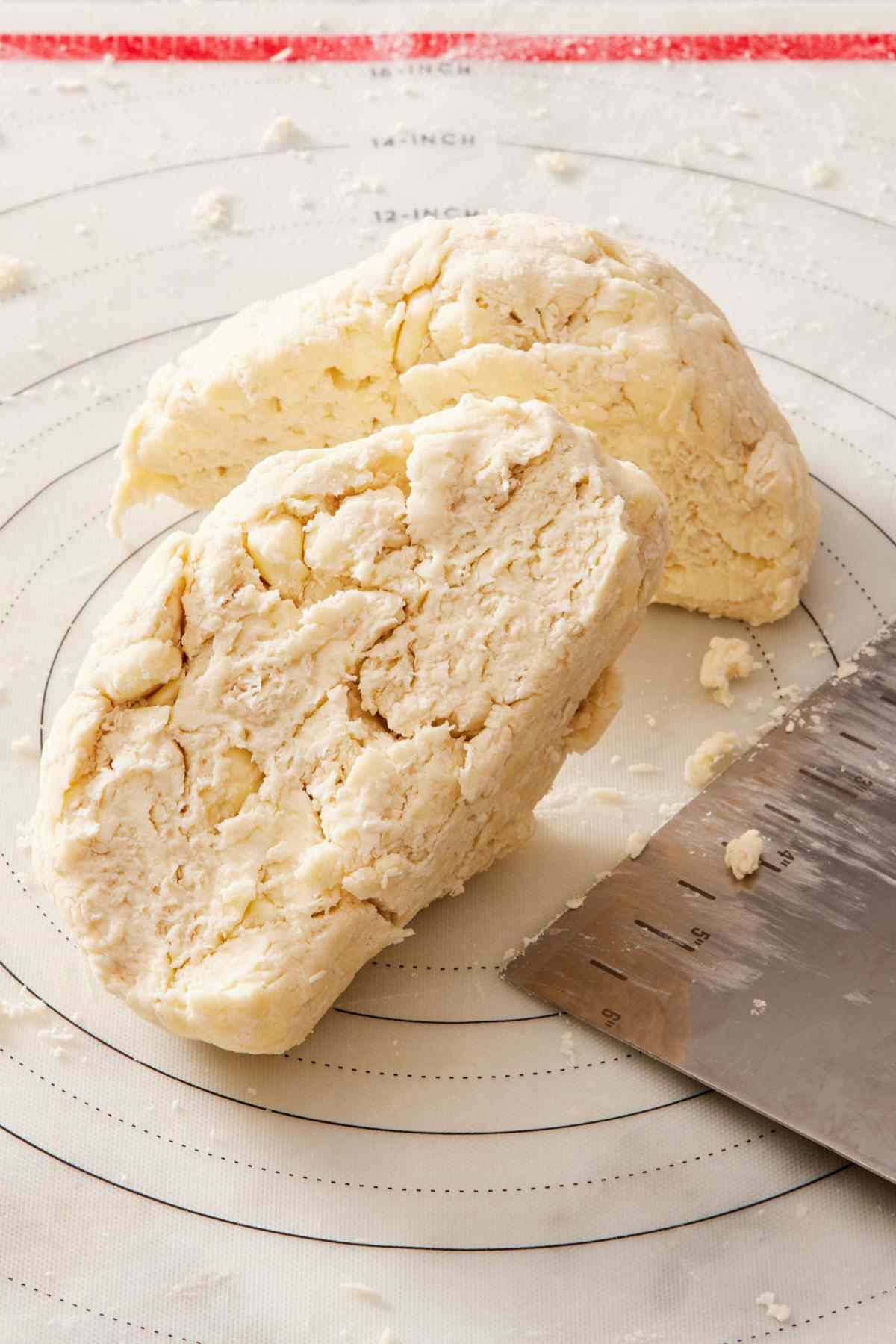
Is Shortening Or Butter Better For A Flaky Crust?
Everyone seems to have their own (sometimes strong) opinion on what’s best! Personally, I prefer only butter in my pie crust. When my executive editor Sarah cross tested my homemade pie crust recipe, she found that shortening didn’t really improve or harm the flakiness of the dough. But the flavor of using only butter was much better!
If you would like to use shortening, you can swap half of the butter for shortening. To do so, use a shortening stick (not the tub) and cut it into cubes. Add it along with the butter in each stage as directed in the recipe.
Key Ingredients
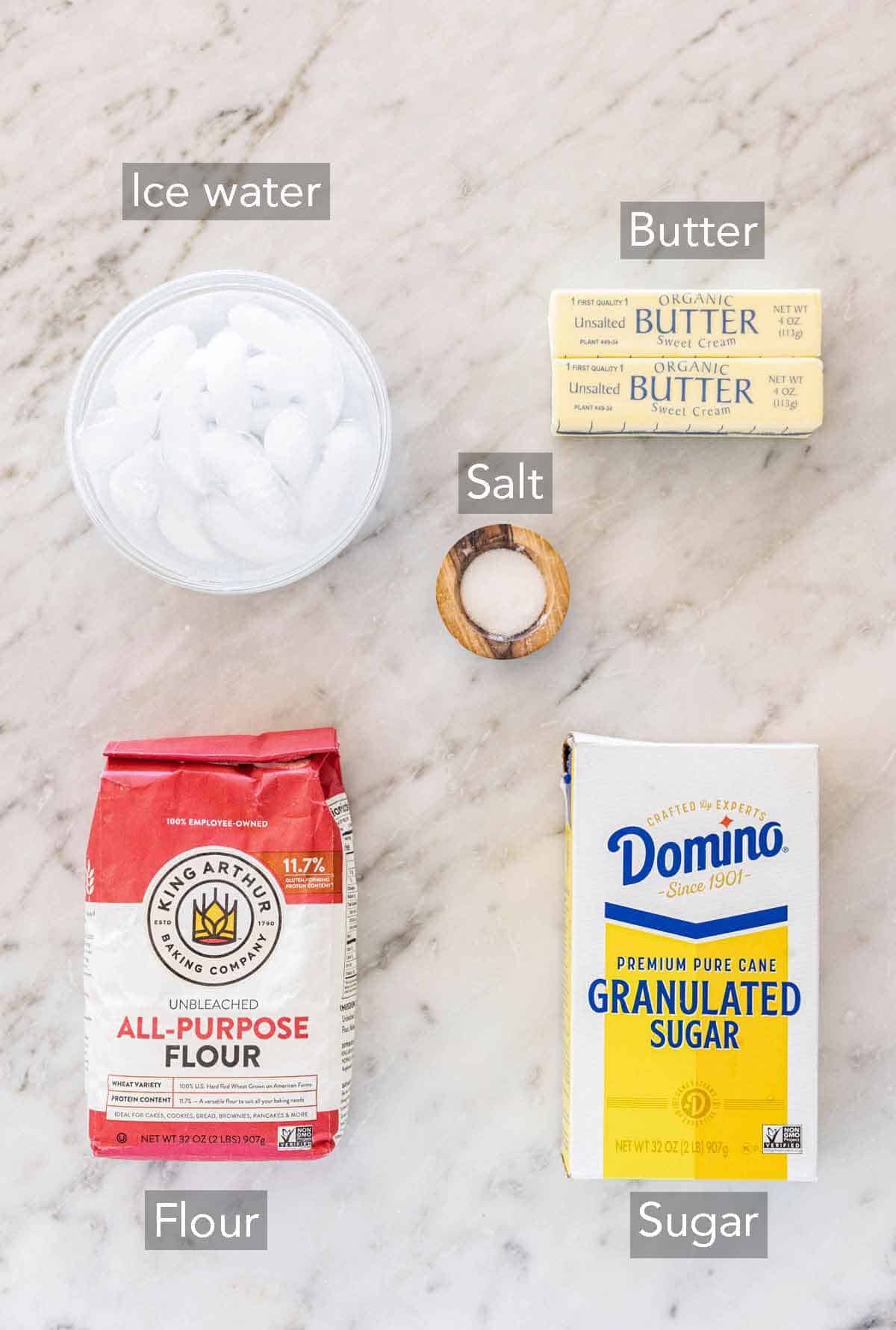
You only need 5 ingredients to make the perfect pie crust. You can find the full list of ingredients and measurements in the recipe card below.
Flour — for this pie crust recipe, you will need all-purpose flour. The medium protein content in AP flour is ideal for a tender, flaky crust. A higher protein flour, like bread flour, will result in a tough and chewy crust, and low-protein cake flour is too delicate, causing the crust to fall apart.
Butter — make sure you use unsalted butter since salt is added separately. You can use American sticks or European-style butter for this recipe! Euro butter will make a richer crust, but I have tested this recipe with great results from both kinds. Also, as mentioned above, cold butter makes for a flaky crust, so keep it in the fridge until ready to use. You can even cube it ahead of time and place it back in the fridge.
Ice Water — cold liquid is essential for keeping the butter cold as you make the dough. I typically fill a larger container with ice and cold tap water, then measure out each tablespoon when I add it to the food processor. If you want to flavor the dough, replace some or all of the water with orange juice, vodka, rum, or apple cider! (Just be sure to chill it with ice, too.)
Sugar and salt — both salt and sugar work together to flavor the crust. The sugar also helps the crust brown.
Why I Use A Food Processor
When I redeveloped my easy pie crust recipe several years ago, I changed my main process from making it by hand to using a food processor. I heard from several readers that making pie crust by hand was very intimidating and that they regularly ended up with dense, tough, or dry crusts. While this new method does require a special appliance, I found that it was the most foolproof method for creating a tender pie crust, whether you’re a novice or an experienced baker. Here are the main advantages of using a food processor:
- Lessens gluten development. The first stage of the recipe is to fully mix part of the butter with part of the flour until it’s fully combined (not large pieces!). This stage coats the flour with fat, which prevents the flour from absorbing as much water and, therefore, not developing gluten. The result is a super tender crust! (With pie crust, gluten development leads to a tough crust that shrinks during baking, so we want to avoid it.)
- It’s easier to incorporate the butter and water. You don’t have to rely on elbow grease to work the butter into the flour! Plus, the food processor incorporates the water faster and more thoroughly, so I often end up needing less liquid, and I don’t risk over-mixing the dough (aka developing gluten). Again, this leads to a flakier, more tender crust!
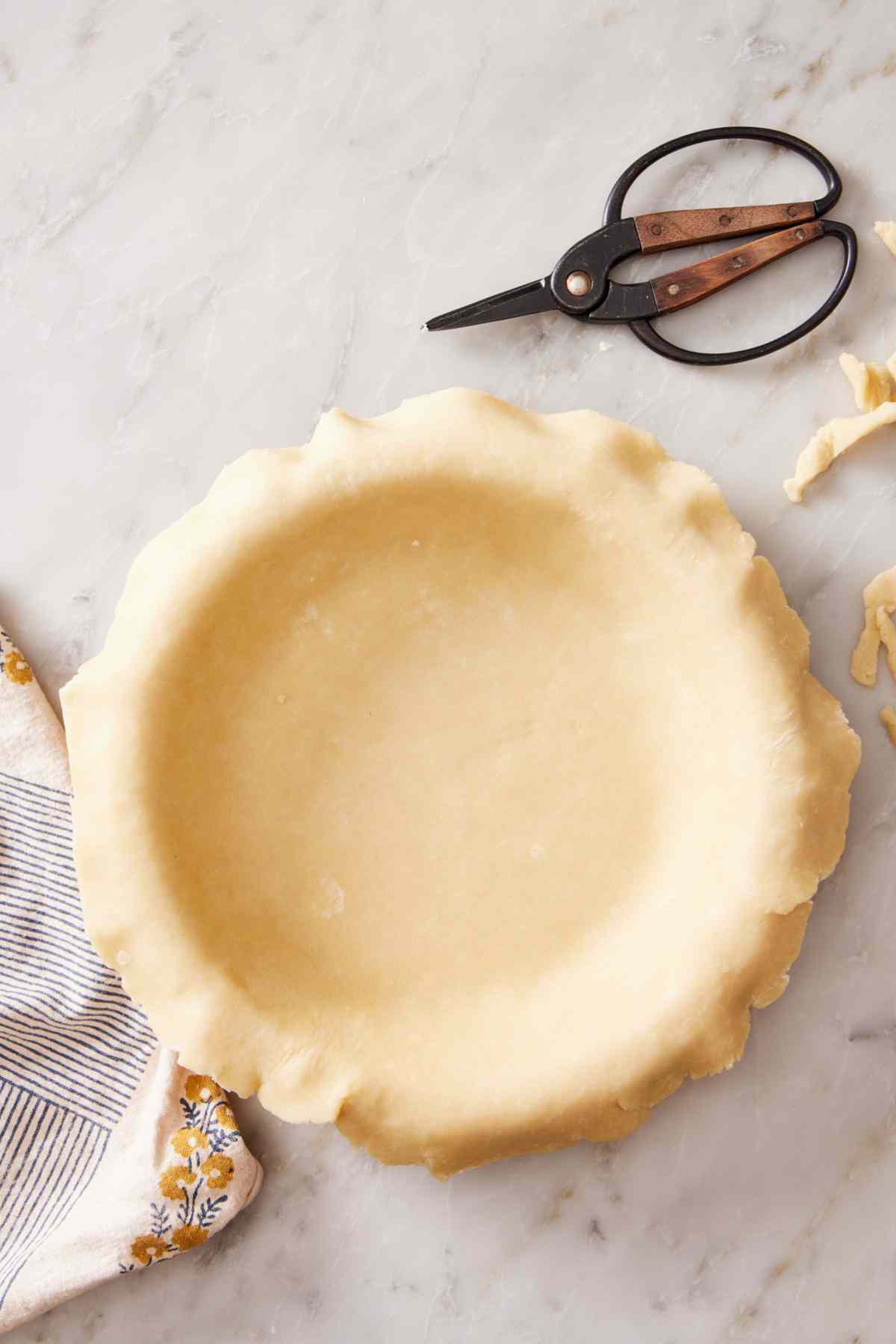
How To Tell If You Added Enough Water
Once the water is added to the food processor and mixed in, the pie dough may still look crumbly in the food processor. The best test is the pinch test! Grab a small amount of dough in your hand and squeeze it together. If it holds together well, it’s ready! If it falls apart, add a little more water. You can see in the image below that the dough on the left is far too dry. It was still floury and crumbly when pressed into a disc. A dry dough will not roll out well and will crack or fall apart when you try to shape it in the pan.
The dough on the right has too much water added, and the outside of the dough was very sticky. If this happens, you can use it, but flour your surface well when you roll it out (the extra flour will help absorb some of the extra moisture). The wetter dough might be a bit tougher when baked, but it should still make a delicious pie crust!
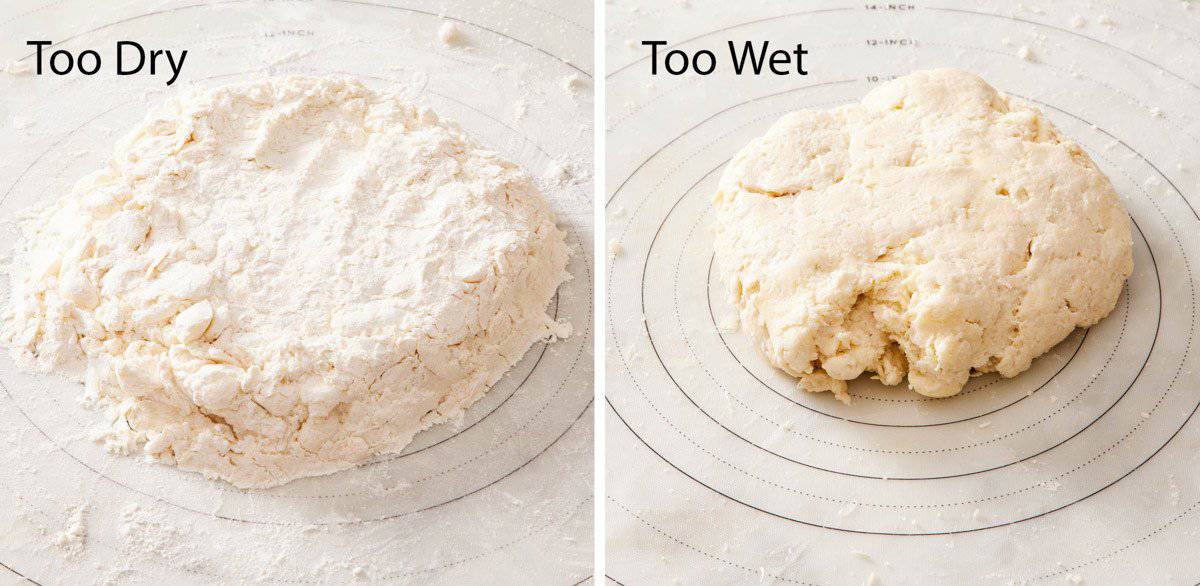
Pro Tips For Making The Best Pie Dough
Use a scale to measure your flour. This will yield the most accurate results. However, if you don’t have a scale, fluff your flour with a spoon and then spoon it into your cups before leveling it off with a knife. This method is the best way to measure flour without overpacking the measuring cup, leading to a dry and crumbly pie crust.
You should also still see lumps of butter in the finished dough. Remember, these are future flakes! When you mix in the water, try to pulse as minimally as possible so you don’t blend the second batch of butter in too much. (Bigger pieces of butter result in bigger flakes in the crust.)
This recipe makes two pie crusts. That’s enough for one double-crust pie or two single-crust pies. If you only need one pie crust, I recommend making the full recipe and freezing the second disc! That way, you have a pie crust ready for next time.
How To Make Pie Crust
Below, I’ve highlighted portions of the recipe in step-by-step process images along with instructions for making a flaky pie dough. You can find the full set of instructions in the recipe card below.
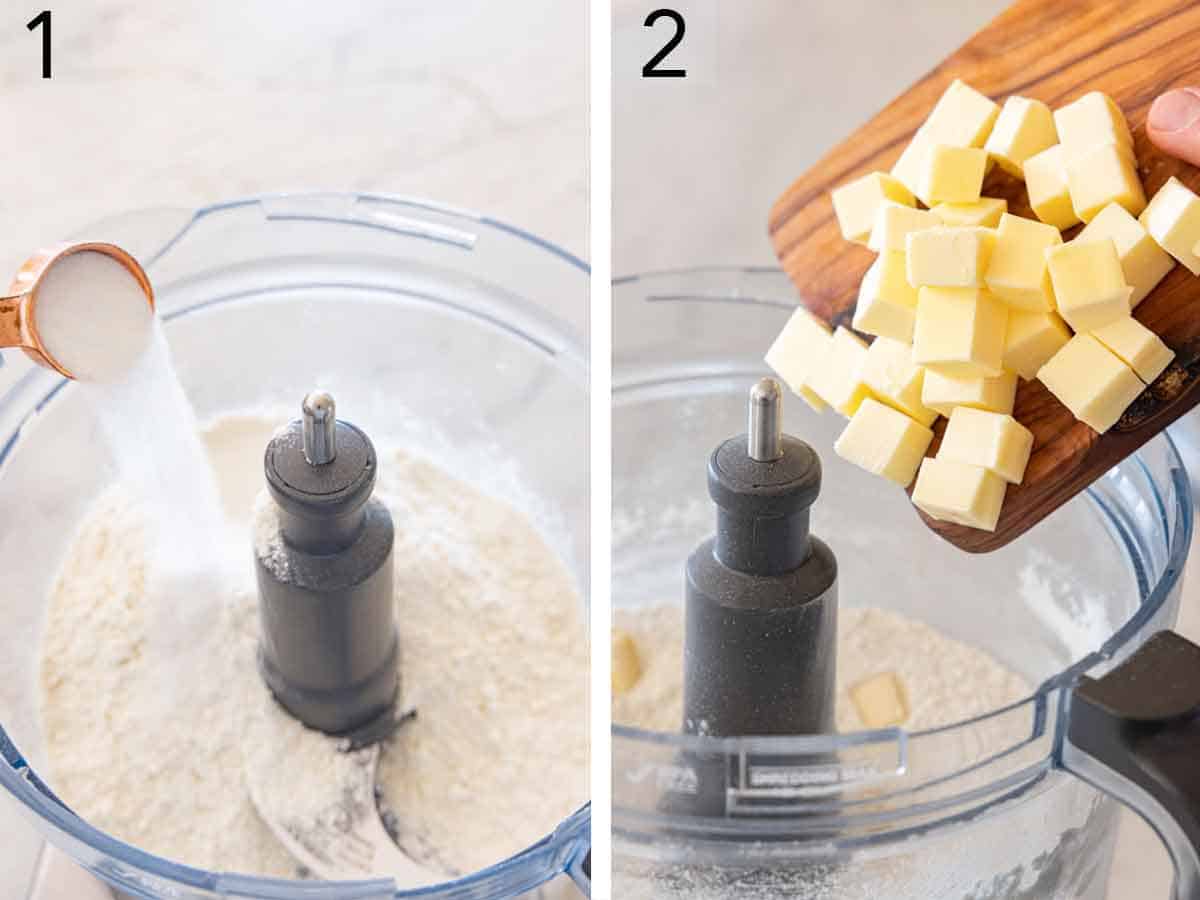
1. In the bowl of a large food processor, combine half of the flour along with the sugar and salt. Pulse a few times to mix the dry ingredients together.
2. Add half of the butter. (It doesn’t matter if the cubes are larger or smaller for this step.)
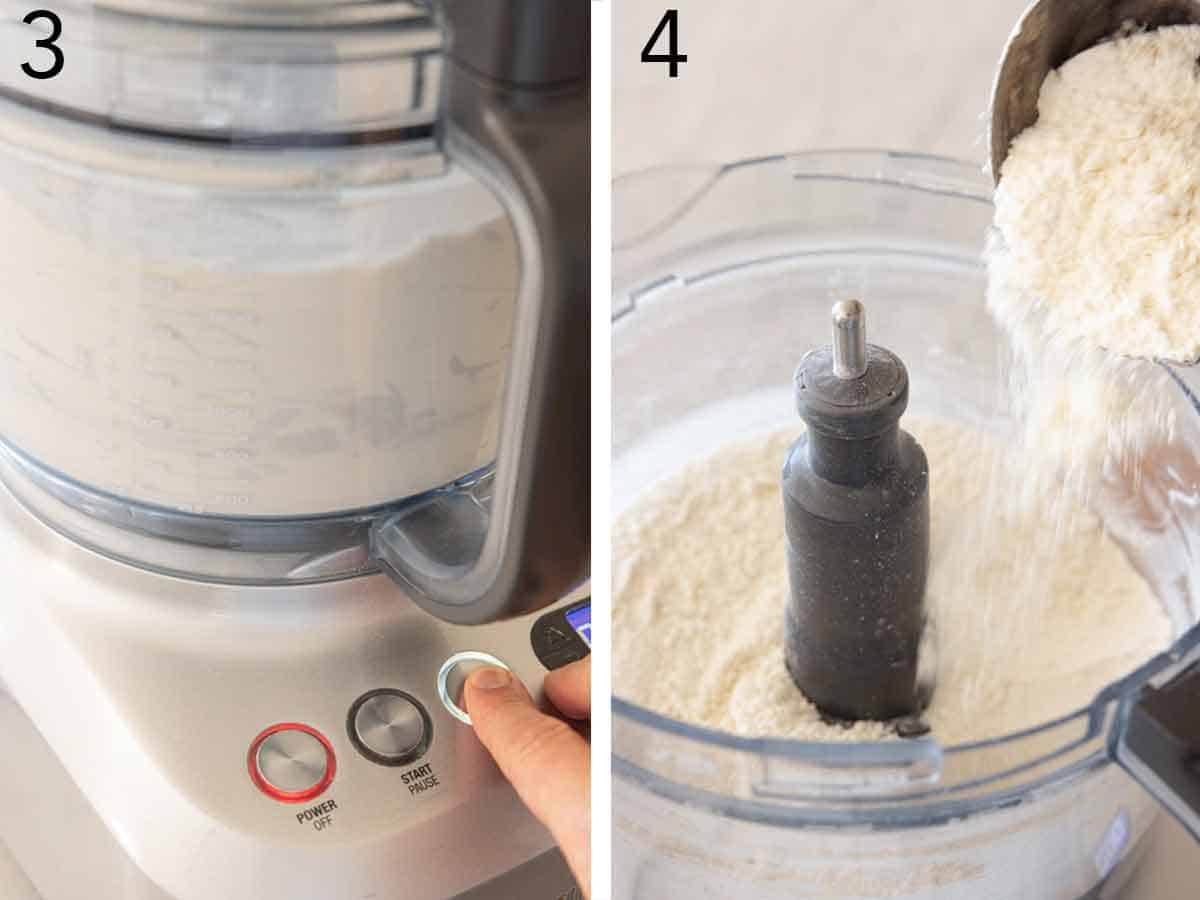
3. Process until the mixture is very crumbly and starts to form tiny balls, 30 seconds to 1 minute. (You should not see any chunks or large pieces of butter at this stage.)
4. Add the remaining flour to the food processor, then scatter the remaining butter pieces throughout the bowl. Cover and pulse twice to coat the butter with flour.
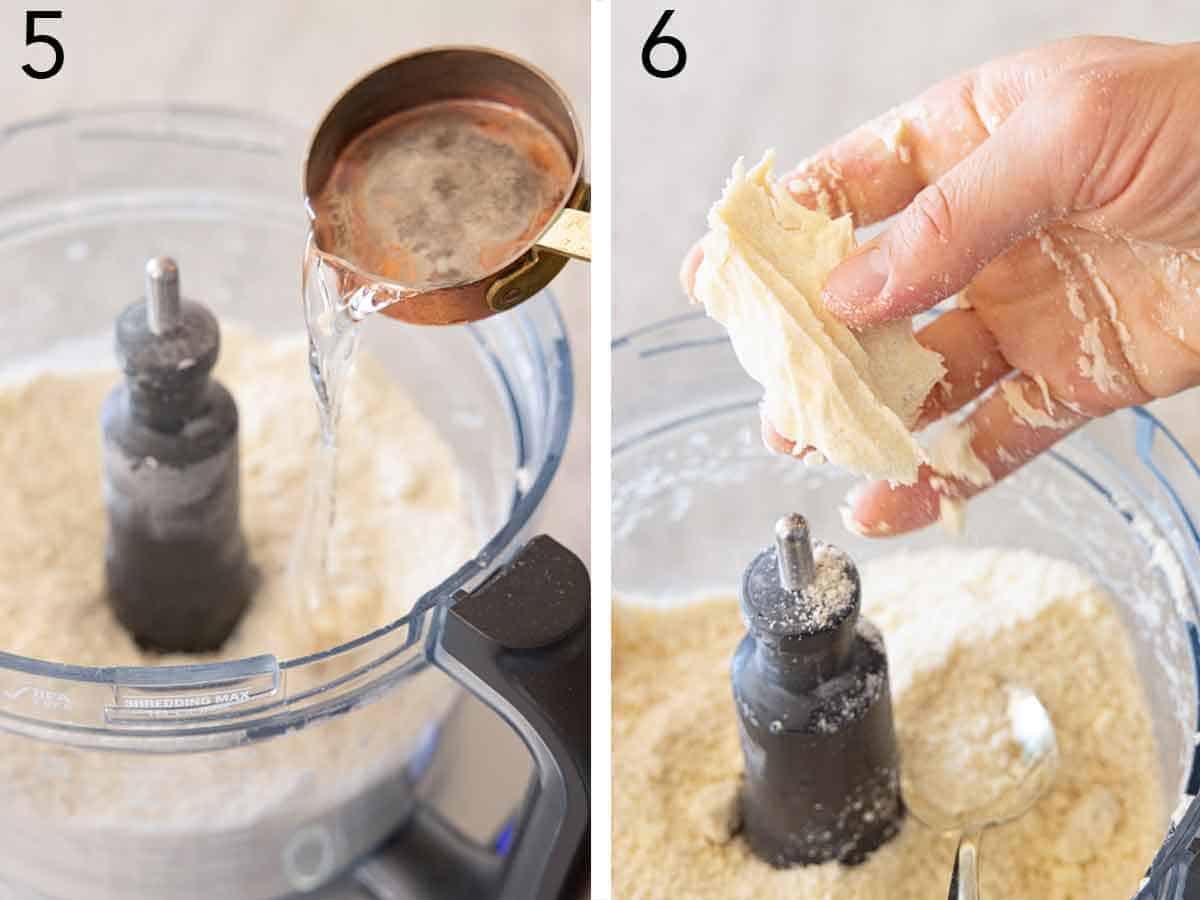
5. Drizzle in 4 tablespoons of water and pulse a few times just to work the water into the flour mixture.
6. Check the dough by pinching a small amount in your hand. If it holds together, you’re good to go. If it falls apart, drizzle in more water and pulse again as needed.
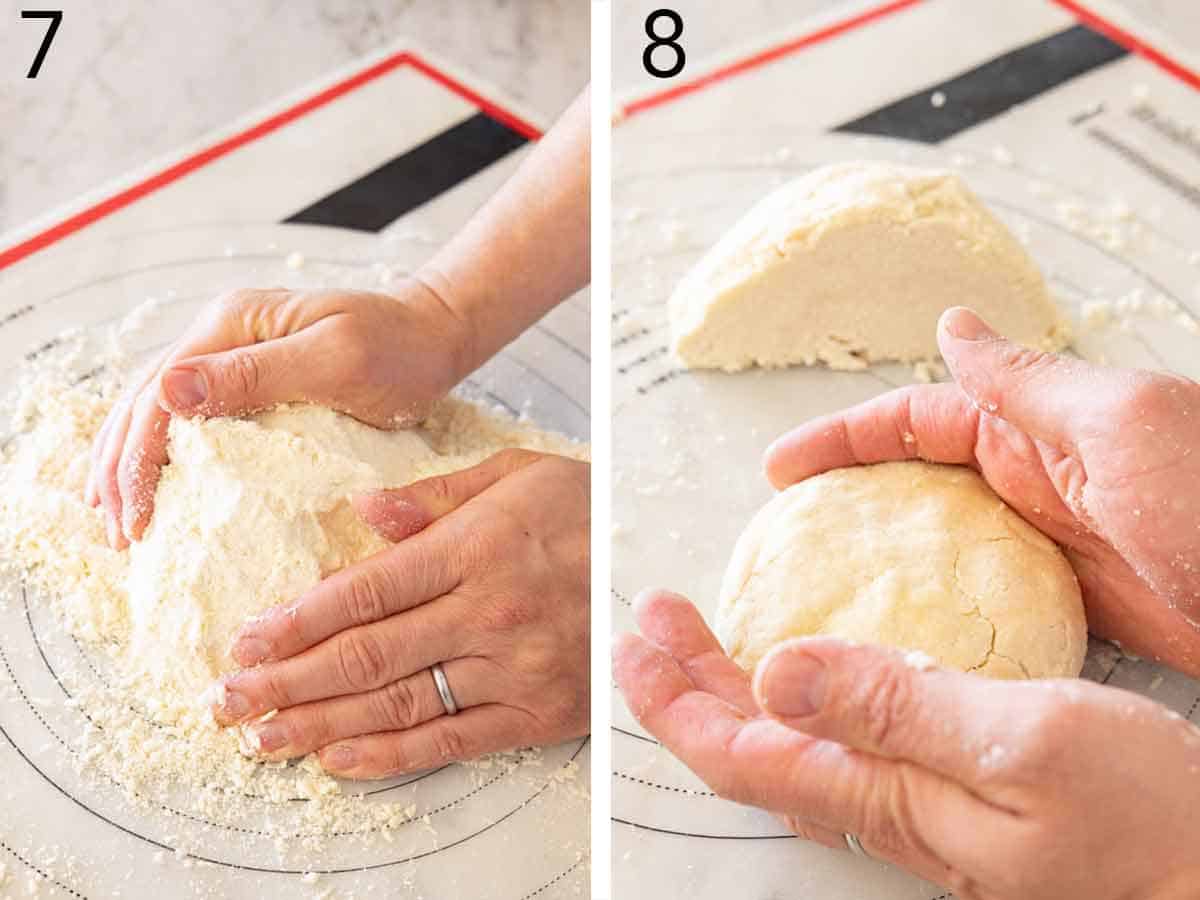
7. Dump the crust mixture onto your work surface and press it together to form a ball. You can gently knead the dough a few times as well to get it to stick together.
8. Cut the large dough ball in half, then shape each half into a ½-inch thick disc. Wrap tightly in plastic wrap and refrigerate for at least 1 hour before rolling it.
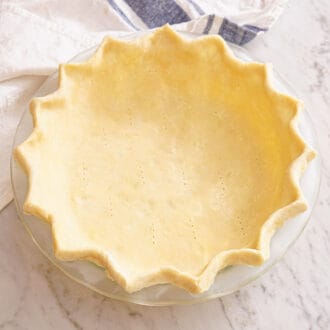
Pie Crust Recipe
Video
Equipment
- Food Processor
- Plastic wrap
Ingredients
- 3 cups all-purpose flour divided (360g)
- 1 tablespoon granulated sugar
- 1 teaspoon salt
- 1 cup cold unsalted butter cut into cubes (227g)
- 4 to 6 tablespoons ice water (60-90ml)
Instructions
- In the work bowl of a food processor, combine 1½ cups (180g) of flour, sugar, and salt. Pulse a few times to combine.
- Add half of the butter. Process until very crumbly and starting to ball up, about 30 seconds. Scatter in the remaining butter and the remaining 1½ cups of flour. Pulse 2 times just to distribute.
- Drizzle 4 tablespoons (60ml) of ice water over the mixture. Pulse a few times. Add additional water, a tablespoon at a time, as needed, and pulse once or twice after each addition. The mixture should easily stick together when squeezed, but not feel wet or dry.
- Transfer the dough onto the counter and form into a ball. Cut the ball in half and press each half into a disc. Wrap tightly in plastic wrap and refrigerate for at least 1 hour or up to 3 days. The disks can also be frozen for a few months and thawed in the fridge overnight before using.
Notes
- Can I make this ahead of time? Yes! Since pie dough keeps well in the fridge for up to 3 days, I often make the dough at least a day before I plan to make the pie. (It makes pie baking day that much easier!) After that, it may start to turn grey as the flour and butter oxidize. For longer storage, freeze the discs for up to 6 months.
- Use this dough for a sweet or savory pie recipe! Even though there’s a small amount of sugar in the crust, this pie dough isn’t sweet. It works as well for quiche as it does for pumpkin pie!
Nutrition
How Do I Make Pie Dough By Hand?
If you don’t have a food processor, you can use this same recipe with a few modifications. Here’s how to make it, along with process images to show you how each step looks!
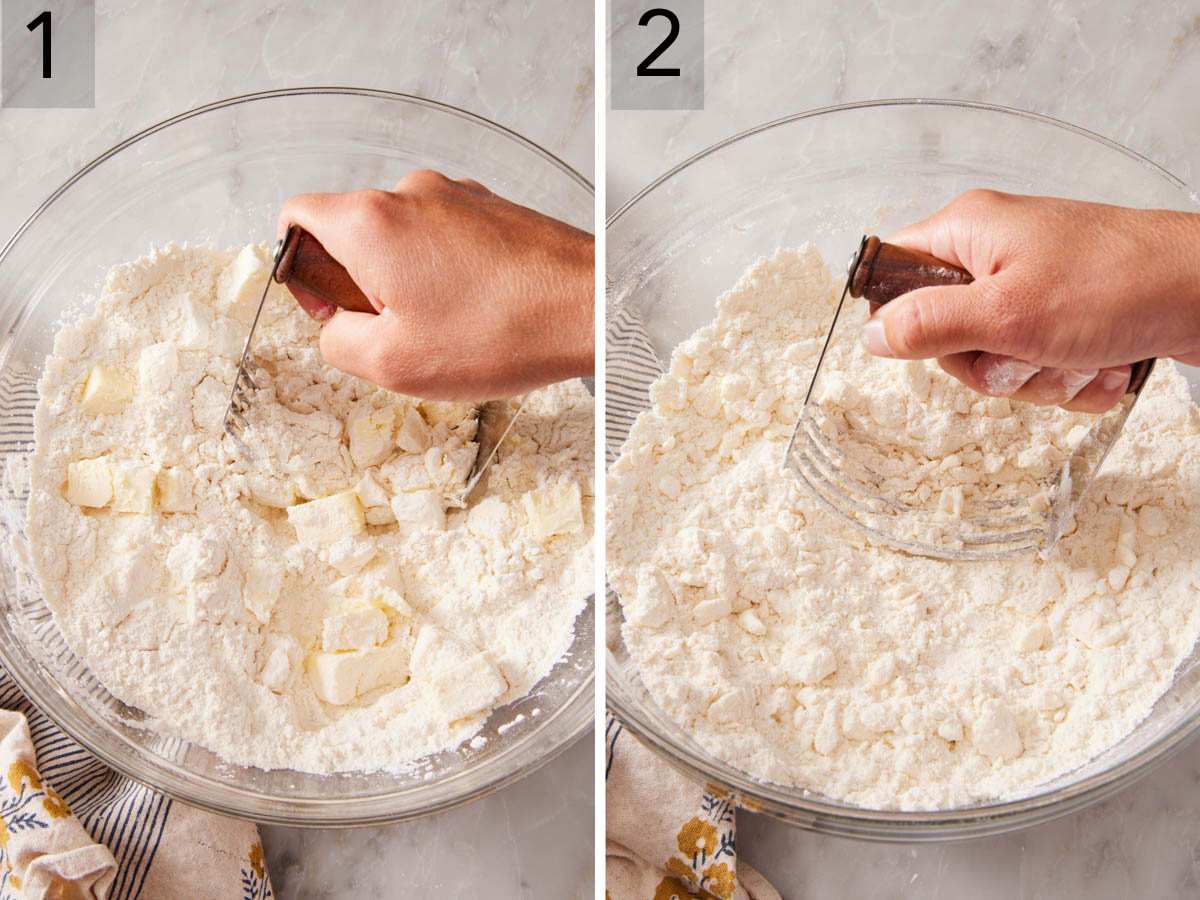
1. Combine all of the flour, sugar, and salt in a large mixing bowl. Toss in the butter to coat with flour, and then cut the butter into the flour mixture with a pastry cutter or by rubbing the pieces between your thumbs and index fingers.
2. Work the butter until the pieces range in size from pea to almonds.
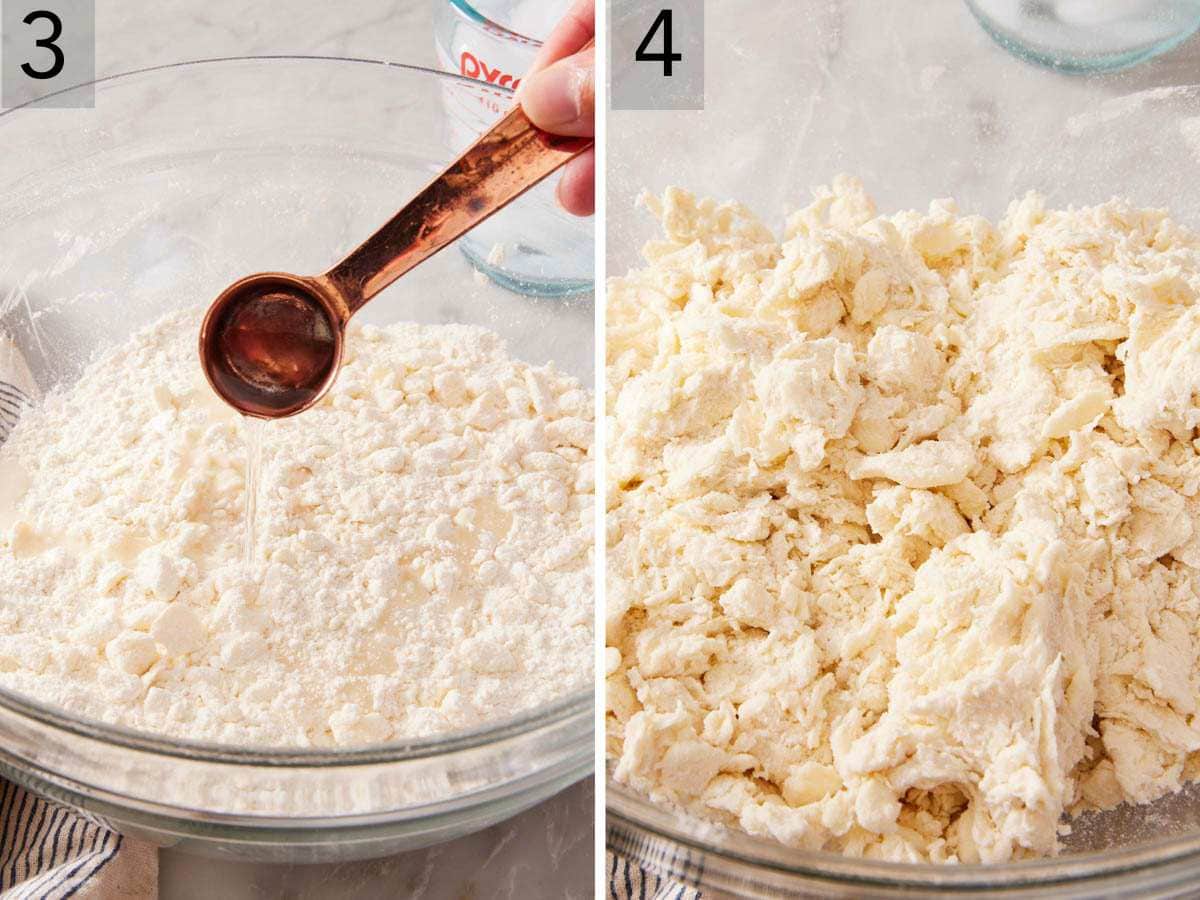
3. Drizzle in 4 tablespoons of cold water and stir it in with a spatula or fork. Add another teaspoon of water as needed to work in any dry pockets of flour.
4. Once the water is incorporated, the dough will look shaggy and start to clump together. There shouldn’t be any very dry or floury places left in the dough. If there are, sprinkle a little more water on those areas. Then, very gently knead the dough just until it forms a solid mass. Divide the dough in half, shape each half into discs, then wrap and chill as directed.
Can I Freeze Pie Dough?
Absolutely! This is one of the best ways to prepare for busy holiday seasons or when you want to make pie more easily at any time. Once the dough has been shaped into discs and wrapped in plastic wrap, place it in a freezer container and freeze for up to 6 months.
To use, thaw in the fridge for 24 hours, then let the dough sit on your counter for 10 to 15 minutes to soften slightly before rolling it.
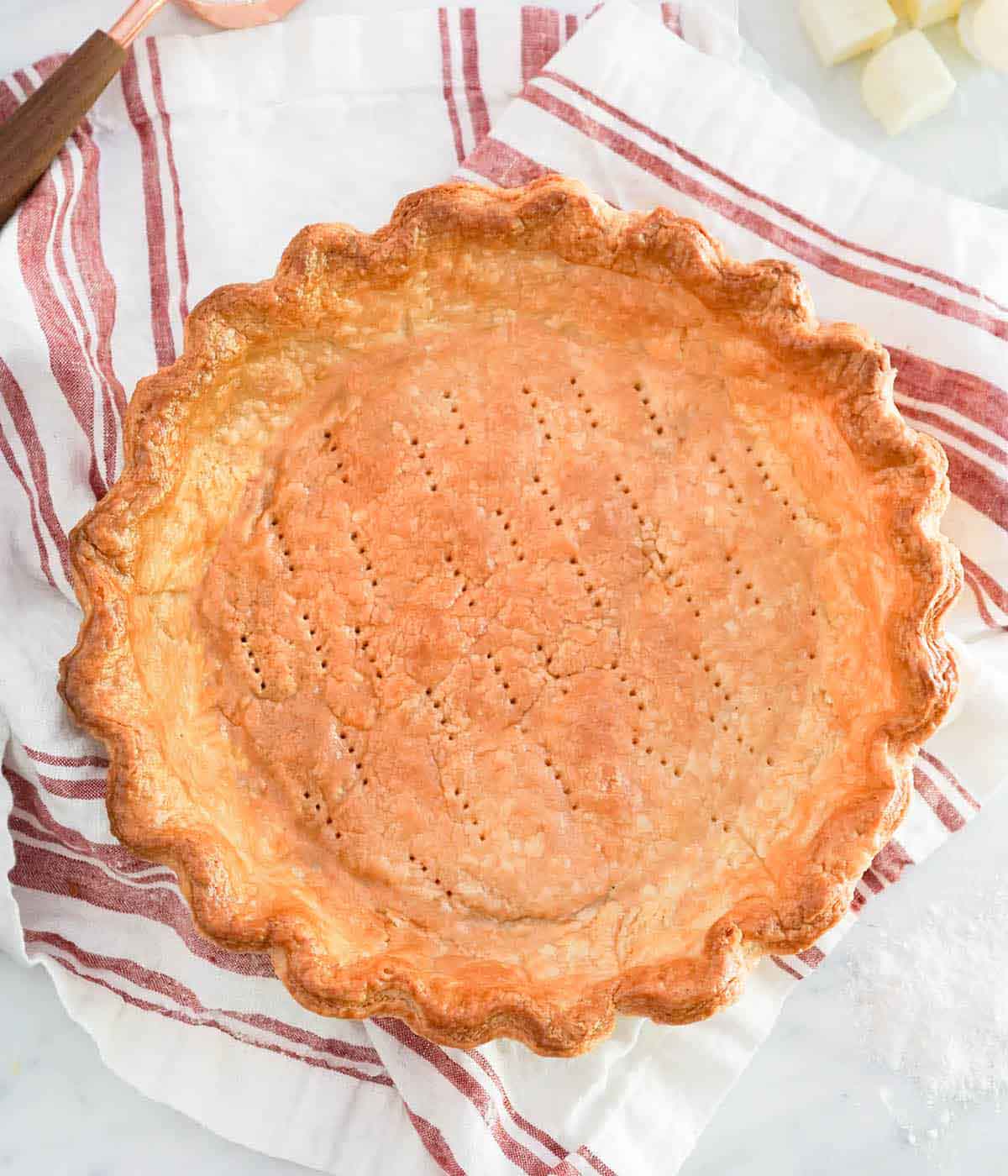
Rolling And Shaping A Pie Crust
When you’re ready to roll your pie dough, be sure to lightly flour your surface and the rolling pin. If the dough has chilled for more than an hour, let it sit on the counter for 10 to 15 minutes to soften slightly before you start. Here are my tips for rolling out an even, round pie dough:
- Start with your rolling pin in the center. Gently press it out to one edge, then rotate the dough about a quarter turn, and continue rolling. I typically keep rolling to one side, but you can do what feels most natural to you and develop an even circle.
- Continue rotating the dough occasionally as you roll. This helps to keep the dough round with an even thickness. It also helps to prevent the dough from sticking to the surface. Add more flour to the surface or your rolling pin as needed.
- If the dough forms major cracks on the edges, press them together, then continue rolling.
- To transfer the dough to the pan, roll it up onto the rolling pin. Then you can place it on top of the pie dish and unroll it.
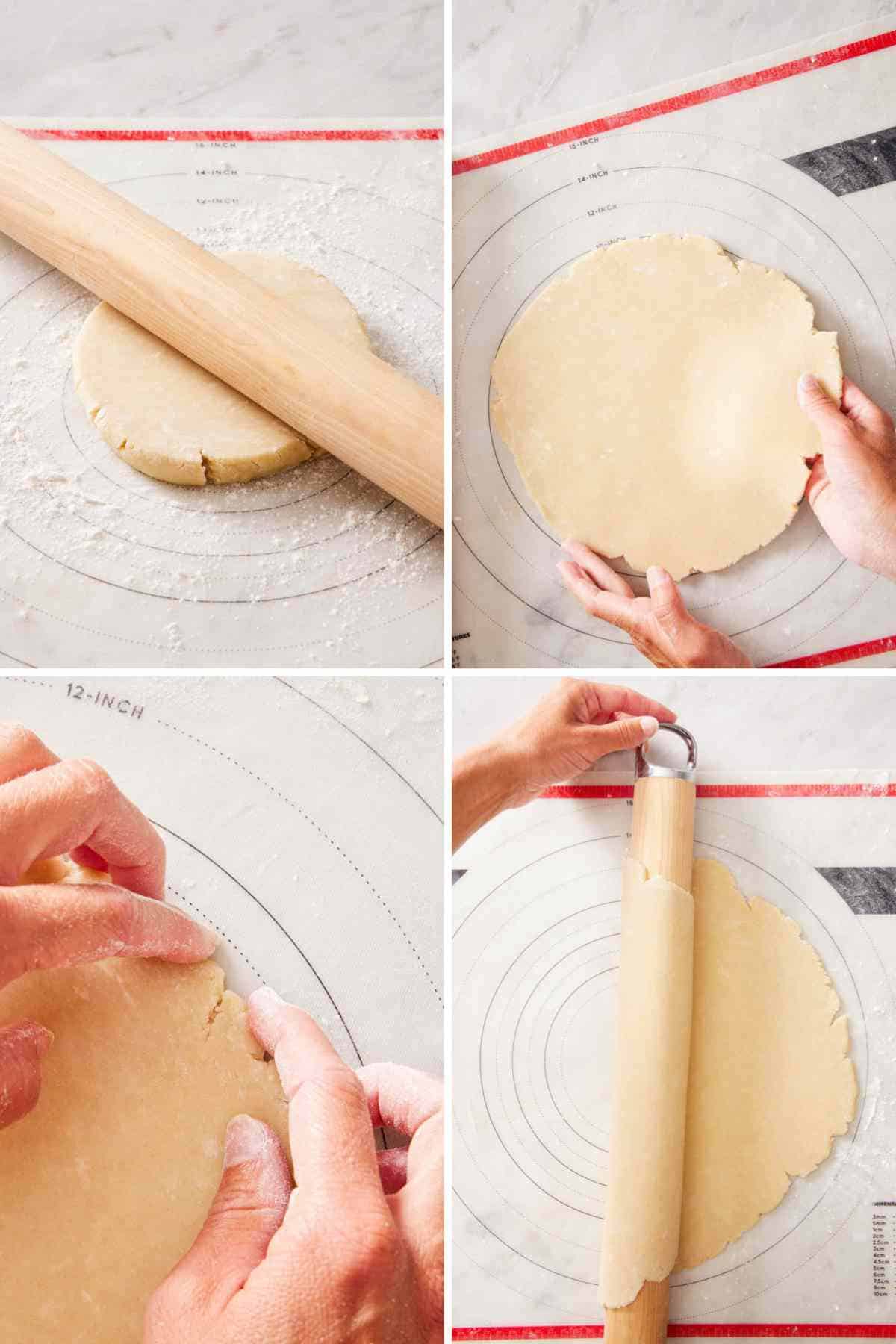
To shape the pie crust in the pan:
- Transfer the dough to the pie plate. Lift it up and press it against the bottom and sides of the pan to form it into shape. Try not to stretch it— that can cause the dough to shrink when it bakes.
- Trim the edges so they are even. Leave about an inch of crust beyond the edge of the pan. If you are making double crust pies, like cherry pie or apple pie, you can wait and trim once the top crust has been added. Once trimmed, tuck the excess under itself and crimp or decorate as desired!
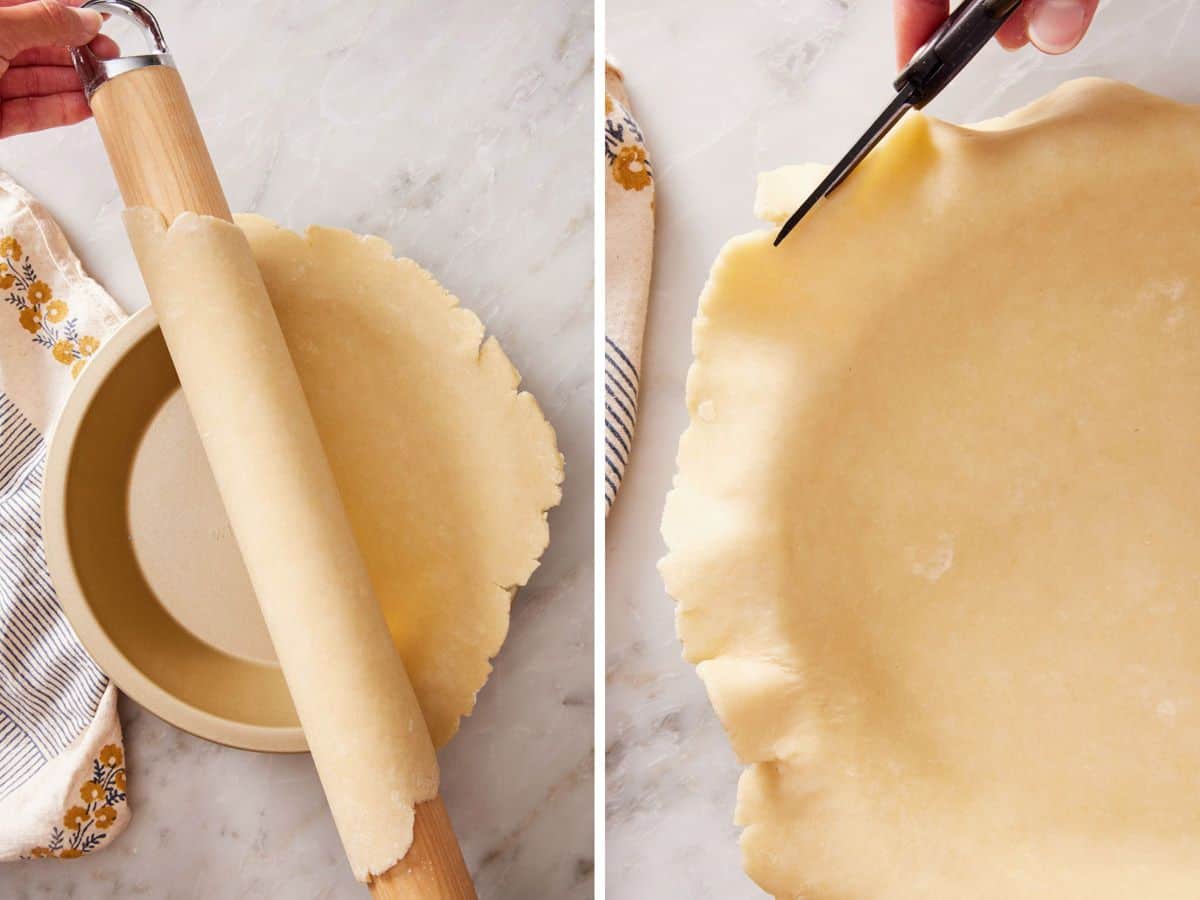
Tips For Blind Baking
If you are making a pie with a no-bake pie filling, like banana cream pie or French silk pie, you will want to bake the pie crust completely before adding the filling (this is called blind baking!). Be sure to freeze the pie crust once it’s shaped in the pan before you bake it. This helps the crust hold its shape. Also, line the crust with parchment paper and foil and fill it with pie weights. This is essential to hold the pie dough in the proper shape so it doesn’t slide down the sides of the pan in the oven. For more tips and full instructions, check out my post on how to blind bake a pie crust!
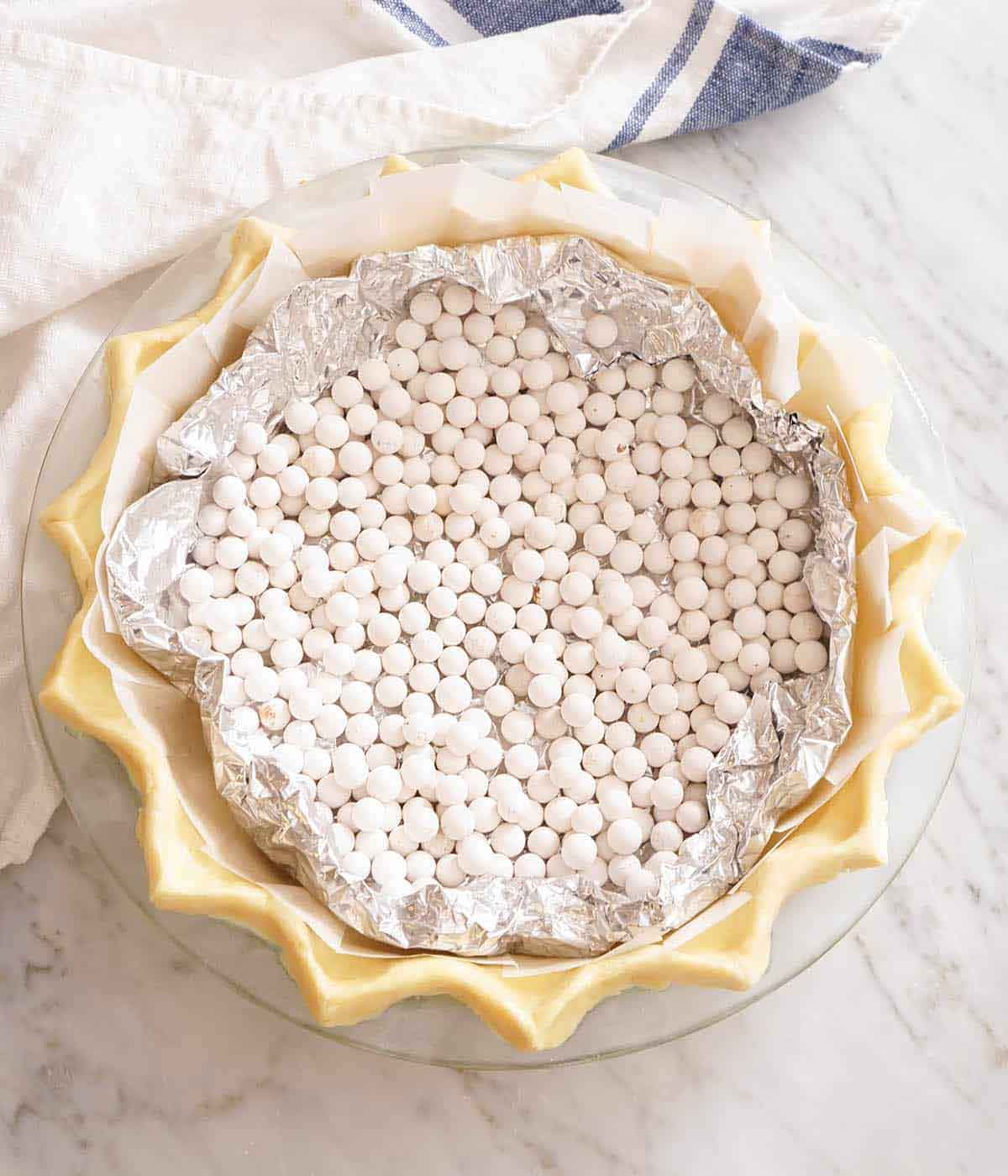
Try One Of These Pie Recipes
Once you have a flaky pie crust, use it to make one of my favorite pie recipes!
Blind bake the crust for a dreamy lemon meringue pie! Fresh lemon juice and zest flavor the curd filling, and it’s topped with a fluffy meringue.
My classic coconut cream pie has a custard filling that is packed with toasted coconut and topped off with homemade whipped cream.
For a delicious diner-style pie, make this chocolate pie! The filling is a simple pudding flavored with rich cocoa powder.
My no-bake peanut butter pie uses an Oreo crumb crust, but you can vary the recipe by placing the fluffy filling in a blind baked pie crust.
If you’ve tried this pie crust recipe, then don’t forget to rate it and let me know how you got on in the comments below. I love hearing from you!



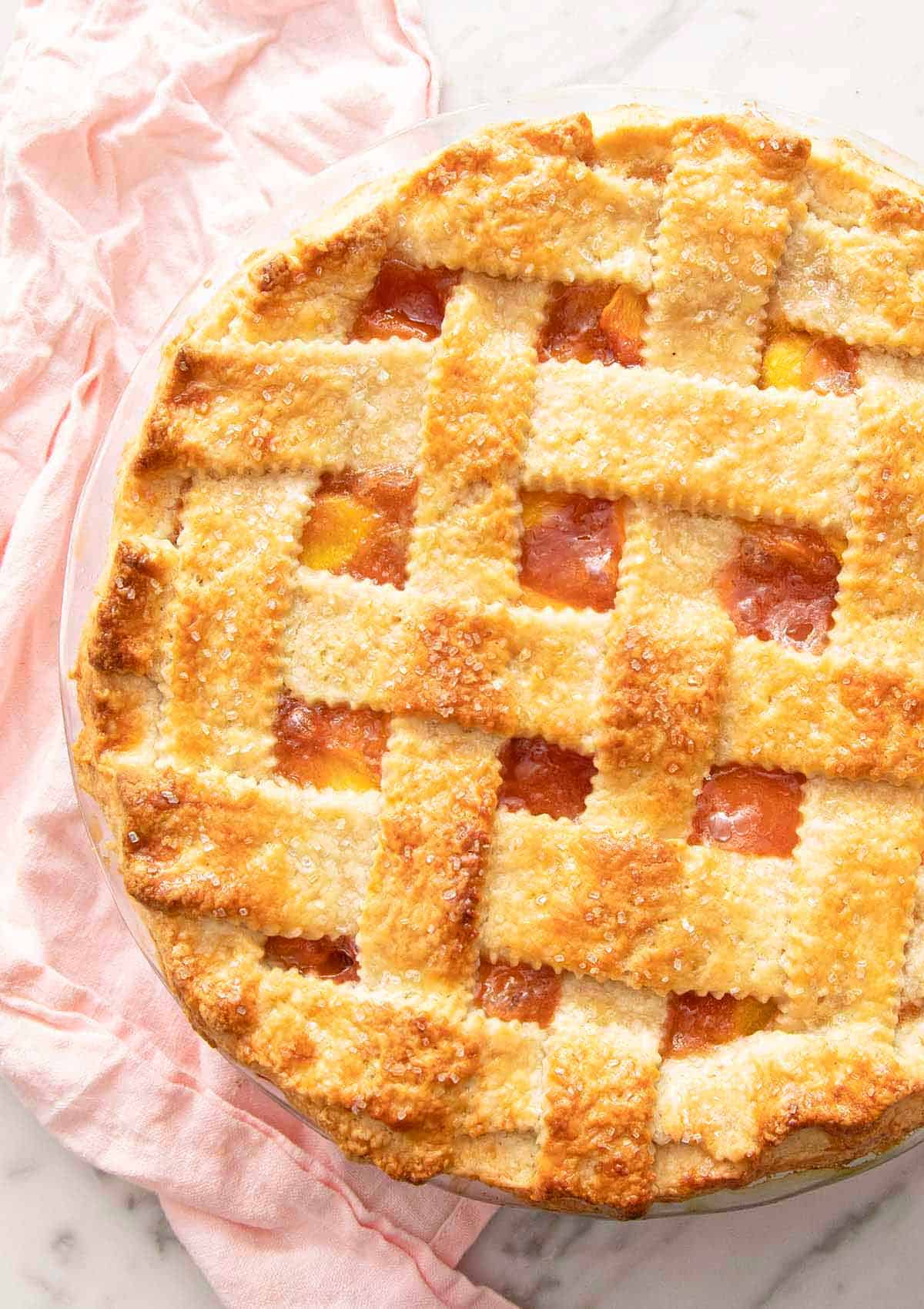
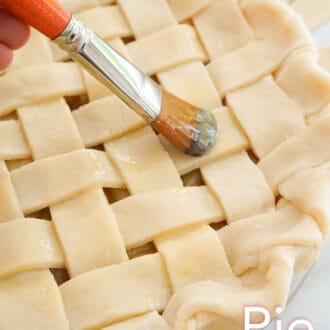
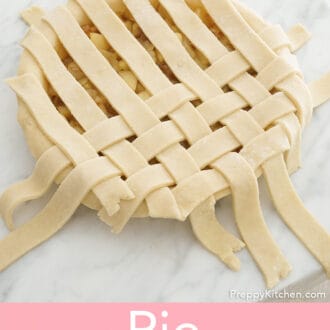
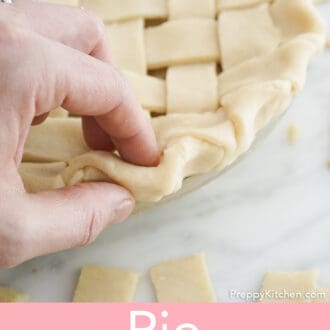
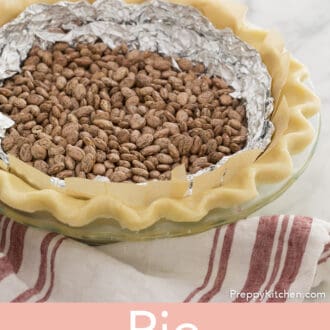
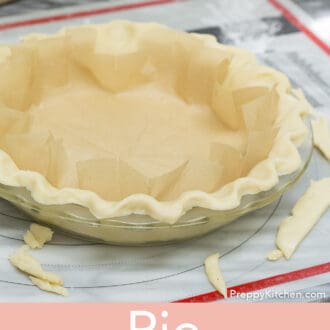
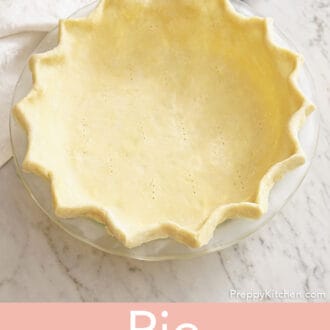
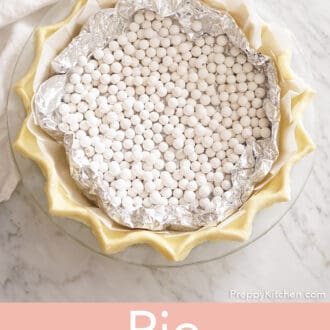
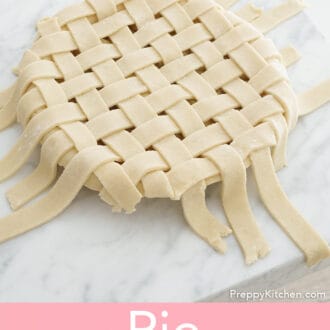
Valerie P says
So. Good. The kitchen was perfumed with butter during the blind bake, and the resulting crust was the star of the quiche! I can’t wait to make another!
Angelique Singer says
Wow! Did I ever learn a LOT from this recipe. The first time I used it I blind baked it for a chocolate pie with meringue which turned out so yummy. My family member commented on how the pastry tasted a bit like toffee because of the butter content.
I put half away in the freezer and used the rest today when I made a pumpkin pie (your recipe) for Thanksgiving. It turned out beautifully scrumptious. Thank you so much for all you do. I really enjoy all your recipes.
Michael Massey says
Simple and delicious! A trick my grandma taught me was to use a cheese grater for the butter then put it back into the fridge to get cold then put it in the flour mixture works really well! Thank you for sharing g your recipes!
Maria says
I love making cinnamon bites with this recipe!! You just cut it in 1inch strips, sprinkle with cinnamon and sugar, roll up and bake! It tastes awwwessomme ❤️❤️
Estela vargas says
Muchas gracia por tu tiempo y tu receta .
Cory Andrews says
I love this pie crust! I Just made it and I was so happy it turned out delicious! Thank you so much.
John Kanell says
Thank you Cory!
Heidi casale says
I used this recipe for my coconut cream pie crust at Thanksgiving this year. It was such a nice soft dough to work with. I like that it asked for vodka and I think it made a difference! I also liked making it in my food processor! So easy!! I have added this to my recipe book and it will be my go-to for all pies from now on! Thank you so much for sharing these fantastic creations with us!
Siobhan says
This is a great recipe!! So easy to follow and he gives nice clear instructions. I watched the video on YouTube Aswell and he speaks so clearly and it’s almost calming. I made it this recipe twice last night for some pineapple custard pies I had to make and they taste delicious today!! Thank you for sharing your recipe along with all the great tips and tricks. Also the blind baking with the foil is such a great tip and also the tip about the foil tents around the edge, GENIUS! Love your recipes and your online content, keep up the great work.
Allison says
Hi – pastry flour or AP flour? Recipe instructions say pastry, ingredient list says AP.
jkanell says
AP flour 🙂
Sunny says
How long can you freeze the pie crust (pre-rolling out), And if you do, how long do you have to leave it out of the freezer to start rolling it out?
Michelle says
I love to hear thorough explanations!! I’ve never heard anybody say to process the butter to lentil sized bits and I can tell you pea sized bits melted down the outsides of my pan dripping onto the oven floor! (Different recipe) I have also never read to fully support the sides of the crust during the pre-bake but I have absolutely experienced the melty shrinking sides. I was about to give up on all butter crust but the flavor of all butter is divine.
What is the difference between pastry flour and all purpose flour in this recipe? Thanks!!
jkanell says
I’m so happy you like the details! Never mind about the pastry flour. It’s all-purpose all the way!